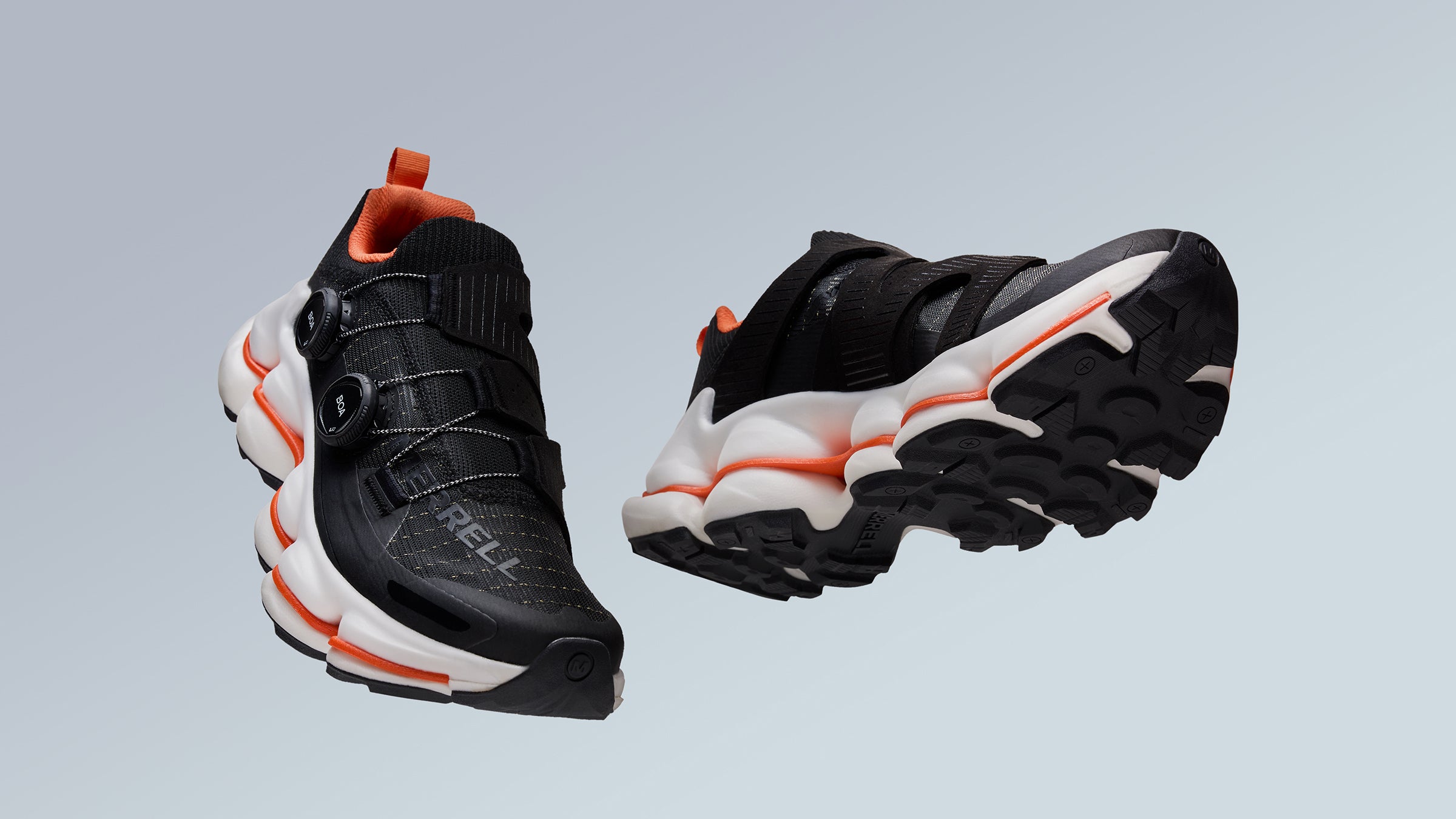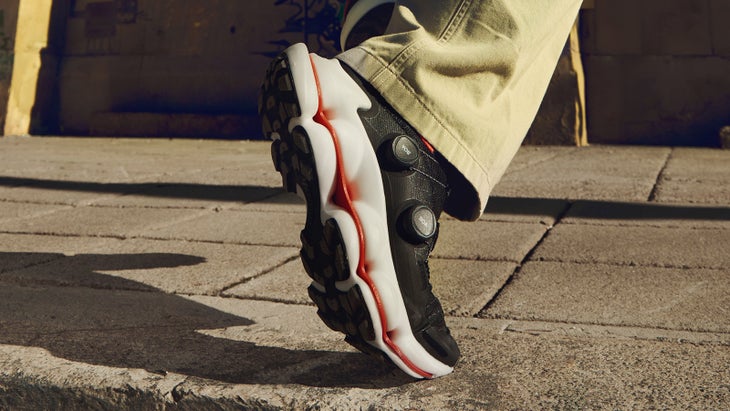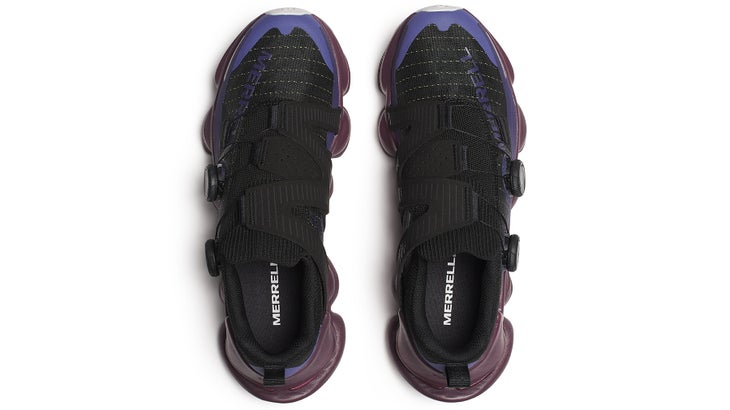If you buy through our links, we may earn an affiliate commission. This supports our mission to get more people active and outside.Learn about Outside Online's affiliate link policy
Merrell’s SpeedArc Surge Is a Super Shoe for Hikers—And It’s Surprisingly Fun to Wear

(Photo: Merrell)
Over the last decade, super shoes like Nike’s Vaporfly have revolutionized distance running. With thick foam and stiff plates, they return enough of the energy produced by the human body to measurably improve performance. Now, a brand better known for comfortable and unassuming boots wants to apply those same merits to your next hike. Can super shoes really make your time outdoors more comfortable? I’ve spent the last two weeks wearing Merrell’s zany new SpeedArc Surge to find out.
If I were to write a description of my ideal hiking footwear, it’d start from the bottom: big, grippy traction lugs, a soft foam outsole, a full-length plate, a supportive mid-sole, a moderate drop of about 8 millimeters, and an upper that prioritizes breathability, all wrapped up in the lightest weight possible. In short, a good pair of trail runners.
The lugs on a great pair of trail runners provide sure grip on loose scree and wet slippery rocks, allowing me to move confidently, no matter the terrain. The soft foam above those lugs should absorb pressure from uneven, pointy rocks—and add a bounce to my step. The plate needs to spread out impact and stabilize the shoe. And the firmer foam between that plate and my foot must support the shape of my feet, helping to spread the load of my weight evenly. The breathable uppers on a well-designed pair of trail runners hold my feet down and protect them from scrapes and pokes, providing the least possible barrier while heat and moisture escape. Each gram saved minimizes the energy each step requires, maximizing the miles I cover.

That description applies to the Merrell SpeedArc—only extrapolated to maximalism. Think of Merrell’s new shoe as a blown-up diagram of your favorite trail runner. You can see each component on the outside, large and clearly delineated.
Similar Reads
Describing the three visible layers that make up the sole, Merrell’s design director, Ian Cobb explains, “The top piece adapts to your foot for immediate cushioning, while the bottom layer adapts to the terrain. The plate acts like a strut bar that brings everything together to push you forward.”
One of the innovations in Nike’s original super shoe was in employing something called supercritical foam to boost energy return to new levels. The material is created by infusing a chemical at its supercritical point—where it’s both a fluid and gas—into a polymer to create a foam with a unique micocellular structure. This is all a nerdy way of saying that new technologies are enabling footwear designers to take foams to hitherto impossible levels of performance: they can tailor specific properties, like cushioning or bounciness, with incredible fidelity, all while reducing weight.
The SpeedArc uses supercritical foam too, for both of the exposed layers in the sole. Merrell says its tailored this material to optimize cushion and propulsion, forming it into “coil-like shapes,” designed to work just like springs.
In its lab testing, compared to the brand’s previous hiking shoes, Cobb says this enables the SpeedArc to deliver, “double the energy return.”
It’s these foam “coils”—and the way the two layers of them are mounted to the central nylon plate—that give the SpeedArc its distinct marshmallow sandwich look, as well as its performance. Its also the prominent separation of the two sole halves, both visually and in terms of performance along with the full-length, full-width plate that distinguishes the SpeedArc from other maxi shoes, like those popularized by Hoka.
While less radical in appearance, the SpeedArc’s uppers are just as innovative. Made from a woven polymer reinforced with Kevlar threads (the yellow lines running across the shoe), the material is incredibly open and very resistant to abrasion. That thin body is then secured with a two-dial BOA lace system. BOA has been replacing laces with wires since 2001, but this is the first time I’ve seen footwear equipped with not one, but two of its dials, which allow you to independently adjust tightness over the forefoot and ankle. This works with polymer overlays that wrap the arch to eliminate hotspots. Together with the seamless upper, that maximizes comfort, and allows you to really cinch your foot down onto the SpeedArc’s soles. This detail helps eliminate the movement between shoe and foot that can cause blisters and fosters a feeling of security that helps the shoes feel reassuringly stable on the trail, despite the height created by the foam coils.

Despite the marshmallow appearance, wearing the SpeedArc doesn’t feel squishy or bouncy at all, just stable and comfortable. Walking along a trail in the SpeedArc reminded me of strolling barefoot across a carpeted room. The experience is utterly unremarkable, until you realize you’re walking across an uneven surface as if it, too, was flat carpet.
Without a laboratory (I write this from an austere cabin bordering Glacier National Park), I can’t speak to numbers, but putting some effort into pace on the trail, the shoes do deliver a tangible feeling of propulsion with every stride.
The only negative here comes from the tread. It doesn’t offer as much grip as many of my trail runners. That appears to be true on both loose dirt, slippery rocks, and even bare metal. While stepping on my truck’s rock sliders to climb onto its roof and wipe dust off of its solar panels this morning—a task I perform several times a week—I slipped.
Aside from that, the SpeedArcs have proven comfortable throughout daily tasks, like carrying heavy furniture into a new guest house, hiking the dogs on mountain trails, and mowing the yard. I’ve reached for these shoes over my usual hiking boots for those tasks thanks to their comfort and stability, but that’s created its own problems. Each and every time I pull them on, my wife rolls her eyes. Reviewing Merrell’s website, we can’t decide if black and purple marshmallows might stand out less than black and white, or white and gold ones.
In 2025, if you want to win a marathon, you almost need to wear a super shoe. But hiking for me is an opposite endeavor, one that turns miles into relaxation and enjoyment instead of records and medals. Do you need a super shoe to enjoy your next hike? Absolutely not. But I’ll be wearing these SpeedArcs through the rest of my miles on trails this summer. My wife will just be walking a few paces ahead, wearing subtle looking trail runners, pretending that she doesn’t know me.
Wes Siler is your guide to leading a more exciting life in the great outdoors. As Outside’s outdoor lifestyle columnist, he writes about the intersections of science, news, politics, gear, vehicles and travel, empowering readers to better understand the world they’re recreating in. Wes lives in Montana with his wife, Virginia McQueen, and their three rescue dogs.


